Artistans
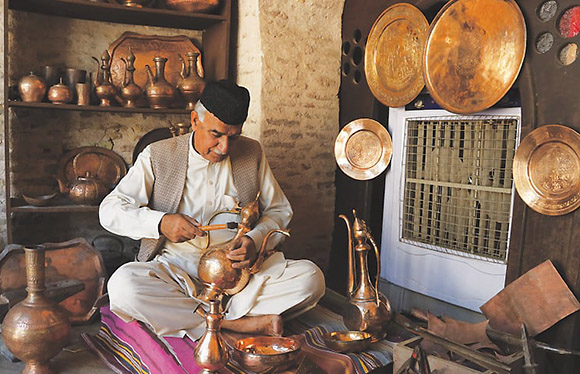
The culturally rich land of Pakistan has a long history of arts and crafts. Not only is the country notable for its amazingly beautiful architecture dating back to the Indus Valley civilization, but it has a name in the production of various forms of art and crafts. From pottery, textile, embroidery, sculpture, and painting to the unique and intricate designs of handicrafts and craftsmanship, Pakistan enjoy all sorts of varieties. Whether it be glass, copper, brass, marble, ceramics, stone, or wood, hardworking and skillful Pakistani artists have left no material when it comes to the expression of their art.
Handicrafts are the elements which express the regional and cultural identities. Pakistan has a rich history of handicrafts and each type shows its beauty, form, dignity, and style. Moreover, handicrafts are not new in the world but it has the 5000 years of history and each country have their styles of making handicrafts. Among other countries, handicrafts of Pakistan have their dignity around the globe and by exporting to other countries they also make the culture alive. Handicrafts of Pakistan come under the umbrella of luxury items for interior decoration.
Colors in Pakistani Art
Colors always attract you and grab your attention at once.
Pakistani art also uses vibrant colors that capture eyes.
These vibrant colors are seen in everything, whether it be stunning jewelry, handmade clothes and fabric designs, footwears or rugs, and carpets.
Usage of Tools
The local artisans of Pakistan spend their lives manufacturing these handicrafts.
They put their sweat and blood in its production.
Although, in today’s world, artisans use machines and more advanced tools to manufacture handicrafts.
However, Pakistani artisans still make use of traditional means and tools to produce unique art pieces.
This is the reason why the products are unique and special, with high quality and distinct designs.
The Bond of Love
With the advancement in science and technology, there is a massive production of goods and items.
You no longer need artisans of Pakistan to work for you and produce art. Now you have machines that can create thousands of copies at one click.
Still in this era of development and tremendous production, the works produced by hands have a special position and demand.
People who know art and share a special bond of love and reverence for art, have great value for such items.
Due to the specialty and specificity of the Pakistani handicrafts and goods, there is a high demand for them in the international market.
Connection to the Homeland Pakistan
Pakistanis living abroad for generations take these handicrafts as a tiny piece of their homeland that build a connection with their country and remind them of their roots. They tend to decorate their homes with cups and dishes made of pottery, special mirrors with Sindhi work, finely wood carved furniture, and many more things. Hence, we bring a list of such stunning items that carry an aura of Pakistani-ens with it. These can be seen as Symbols of Love exclusively from the homeland, that carries the scent and color of Pakistani land.
Glass Bangles of Hyderabad, Karachi
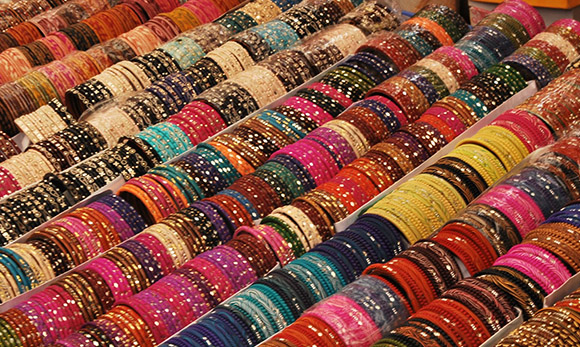
Hyderabad, Karachi is the second largest place where glass bangles are produced after Ferozabad in India. This is the hub of the glass bangles industry because the weather is perfect for its manufacture i.e. dry and hot.
Thousands of people are involved in its production, most of whom are Pakistani women artisans who play a significant role to maintain the identity of the cultural heritage. The makeover and dressing of a South Asian woman are incomplete if she does not wear the colorful and exquisite glass bangles.
These bangles carry a desi Pakistani touch which is celebrated across the country. The bangles are made in all sorts of colors, shapes, and sizes. The major portion of the bangle making is carried out by hand.
Himalayan Salt Crystal Lamps
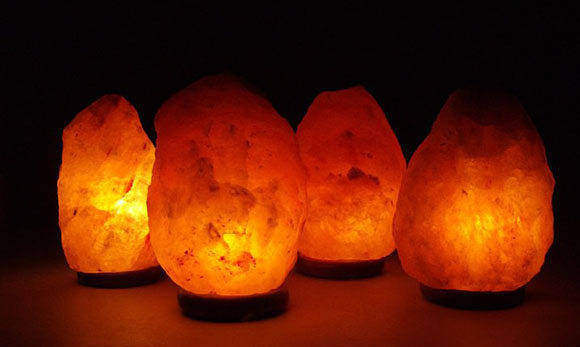
Himalayan Salt Crystal LampsHimalayan Salt Crystal Lamps. The awe-inspiring Himalayan salt lamps are made from rock salt of the famous Himalayan mountains in Pakistan and are used as a great part of home décor.
These lamps come in various beautiful designs, shapes and sizes and people love to decorate their homes and offices with them. They are carefully crafted by hand to preserve the natural shape and structure of the rock. The color ranges from white to apricot and warm pink. Moreover, these lamps have health benefits too, as it is said that they clean the air, soothe allergies and create a healthy peaceful atmosphere.
Camel Skin Lamps
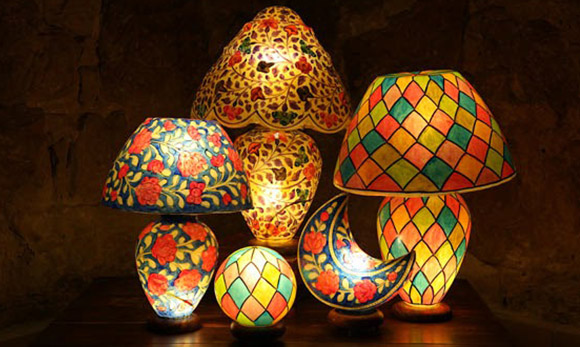
These lamps are made in Multan and are famous for their intricate designs designed by the skilled local artisans of Multan. They are produced from dried camel skin, which is then designed and painted.
The designs reflect the desert culture of the area they are known for. They reflect the desert life of rural Multan and carry a touch of locality and Pakistani culture.
The surface of the lamps is porous so that they produce shadows and when lighted, they can carry you to a distant world of beauty, simplicity and silence.
Kashi Pottery of Multan
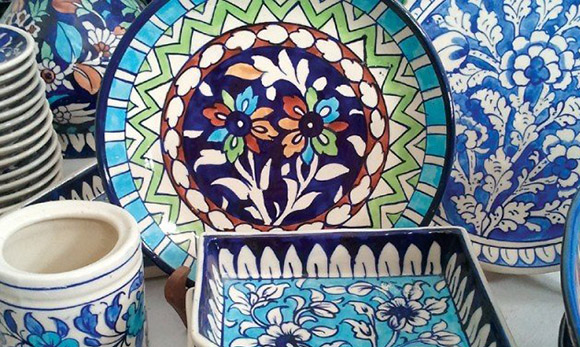
Multan which is one of the oldest cities of the subcontinent is widely known for its famous blue pottery which is also called Kashi pottery. The city has also been the ancient hub of Sufis, so this heavenly color is inspired by the color of their resting places.
This art has its origin in Kashgar in western China and is influenced by Persian arts. However, Pakistani artisans have developed it further by bringing in new designs and giving different forms to it. Nonetheless, the combination of the colors blue and white is the most dominant and famous even now.
Every piece of pottery is handcrafted and hand-painted individually before heat treatment at temperatures around 250 degrees Celsius. The resulting product is immensely beautiful and looks very delicate, yet it is remarkably durable.
Camel Bone Handcrafts
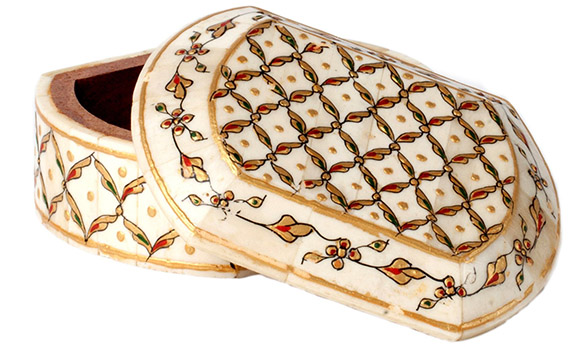
When the availability of ivory lessened, the artisans of Multan thought to experiment with camel bone and their experimentation worked.
Camel is found abundantly in the area of Multan and people use camels for food, transport, and milk, etc. Since the availability of camel bone was not a problem so the artisans used it to replace ivory. Artisans who create camel bone handicrafts make a variety of items, from small key chains to big products, for decoration as well as use. Camel’s bone is tough so the things made from it are durable and the skill and art of the artisans give them the perfect shape and delicacy.
The items made from camel bone include jewellery boxes, key chains, chess boards and decoration pieces such as vases etc.
Peshawari Chappal
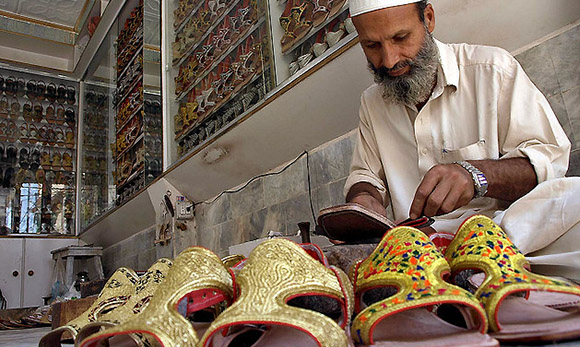
It is the traditional footwear of the Pakhtoons from Khyber Pakhtunkhwa in Pakistan. It takes the name from the area where it is made and it is specific to that area only.
Apart from the use and comfort it gives, Peshawari chappal has the traditional and local touch and is part of the Pakhtoon culture. They consider it a crucial part of their dressing.
It is made up of soft leather by hand and is widely available in various colours and designs. The PM of Pakistan, Imran Khan also buys his Peshawari Chappal from a local artisan in Peshawar.
Hand Made Woolen Shawls of Swat and Gilgit Baltistan
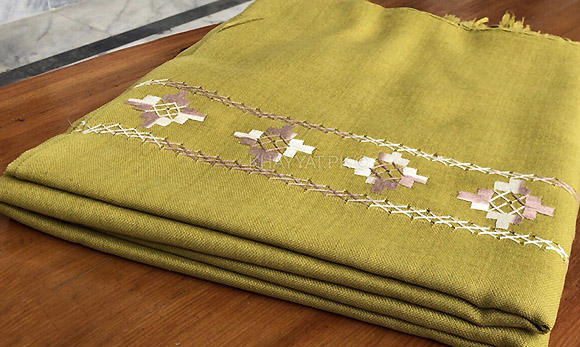
The woollen shawls from Swat and GB are very famous in Pakistan as well as outside Pakistan. These are worn in winters by both men and women. The shawls are made of fine thread, pashmina and other, which are then weaved and made designs upon by the local artisans of both areas.
The material of the shawl is exquisite but the real value of it is due to the delicate and intricate hand made designs on it. Thousands of artisans pf Pakistan work hard to produce these unique shawls which are on high demand once winters arrive.
Traditional Gem Stone Jewelry of Gilgit Baltistan
Gilgit Baltistan is the northern area of Pakistan known for its natural and scenic beauty. This place is also famous for the gemstone jewellery that is part of their indigenous culture and tradition.
The gemstones mostly come from the mountains and land of GB, which are shaped and crafted by the artisans of Pakistan and then sold. The tourists love to collect precious stones and gems from there. The jewellery has simple yet elegant designs that give a cultural look.
Multani Khussa
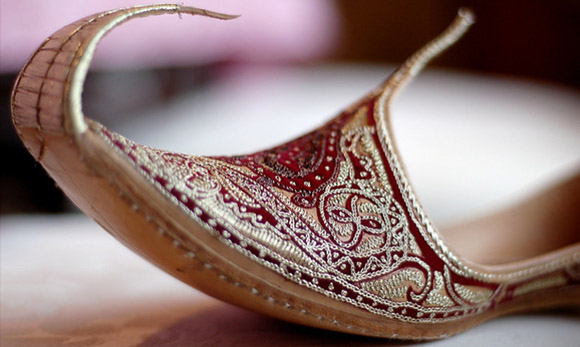
This special footwear which is made in Multan is completely handcrafted and worn by South Asian men and women. It is made of vegetable-tanned leather. Traditionally it was worn by the royalty and elite.
The specialty of khussa is its encapsulation of the cultural and ethnic diversity of the region. There are a huge variety and collection of khussa and people love to buy and wear them.
Handmade Rugs
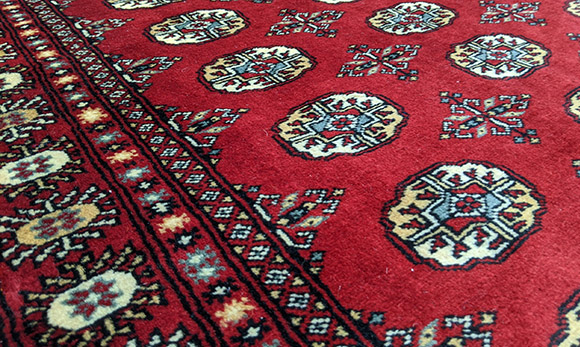
The art of weaving developed in the region comprising Pakistan at a time when few other civilizations employed it. Excavations at Moenjodaro and Harappa - ancient cities of the Indus Valley civilization - have established that the inhabitants used spindles and spun a wide variety of weaving materials. Some historians consider that the Indus Valley civilization first developed the use of woven textiles.
Carpet weaving may have been introduced into the area of present-day Pakistan as far back as the eleventh century with the coming of the first Muslim conquerors, the Afghan Ghaznavids and the Ghaurids. It can with more certainty be traced to the beginning of the Mughal Dynasty in the early sixteenth century, when the last successor of Timur, Babur, extended his rule from Kabul, Afghanistan to Dhaka, Bangladesh and founded the Mughal Empire. Under the patronage of the Mughals, local craftsmen adopted Persian techniques and designs.
During the Mughal period, the carpets made on the South Asia became so famous that demand for them spread abroad. These carpets boasted distinctive designs and high knot densities. Carpets made for the Mughal emperors, including Jahangir and Shah Jahan, were of the finest quality. Under Shah Jahan's reign, Mughal carpet-weaving took on a new aesthetic and entered its classical phase.
Woodwork
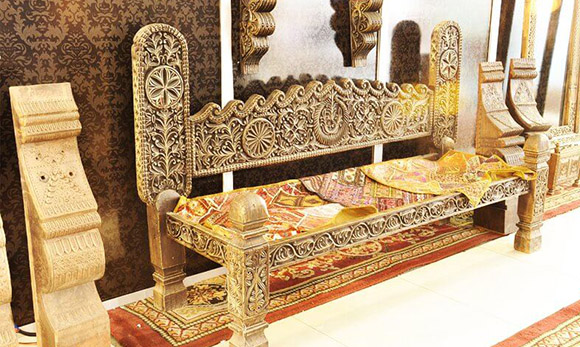
Many of the items are included in this type of handicraft. Sargodha city is famous in wood artwork and lacquer wood artwork in which includes decorative items, wooden pottery, and craving. Chiniot is the main city known for wood craving and quality furniture is also popular there.
The most high-quality wood used in Pakistan is rosewood and it’s only available in Pakistan in Asia. The wooden crafts and furniture is made and craved from rosewood by the craftsmen and is popular across the country due to its quality and uniqueness.
Pottery

Handmade pottery is the most known handicraft of Pakistan and it has a wide history too. Multan, Rawalpindi, Gujrat, and Bahawalpur are the main cities famous in making pottery items in which include decorative items, ceramic pottery tiles and panels, crockery and much more.
Handmade camel skin lamps have also the prominent value in the field of handicrafts and this item has also exported to other countries and people admire it due to its uniqueness.
Love for Pakistani Art
The overview above of the handicrafts that the skilled and passionate artisans of Pakistan create shows that they create their crafts the traditional way that reflects their culture, lifestyle, and love for the country.
From an artistic piece to decorate your mantel or hung on a wall in your bedroom or put on your office table to the exquisite attires, footwear, and dressings, you can find almost anything for any occasion in your life in these adorable Pakistani arts and crafts.